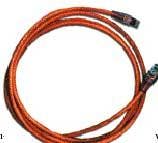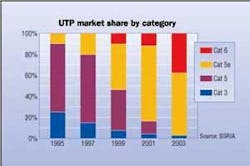Ethernet and UTP are wedded, for better or worse
In 2002, many in the cabling industry believed Category 6 was going to be the "do-all, end-all" unshielded twisted-pair (UTP) cabling, with fiber waiting in the wings as the next logical choice for speeds greater than Gigabit Ethernet. But the marriage of UTP and Ethernet now appears to be a virtually inseparable union as technology drivers and market forces continue to push the limits of UTP. Even as 10-Gigabit Ethernet pushes channel limits to 500 MHz in the looming presence of alien crosstalk, the industry is still looking to UTP for answers. And Augmented Category 6 cabling is on the horizon.
A force to be reckoned with
In 1972, when Bob Metcalfe defined Ethernet's basic principle of collision detection and recovery, he probably didn't foresee twisted-pair telephone cable as the medium of choice. "The real breakthrough came in 1986 when equipment manufacturers introduced intelligent hubs that could transmit Ethernet on existing 100-
While parts of Central Europe, particularly Germany, France, Switzerland, and Austria, adopted shielded twisted-pair cabling as their standard medium, UTP remains the predominant cabling for voice and data transmission in the U.S. and throughout much of the world. "The power of the installed base is a huge market force, and if a company is investing in the development of new hardware or new voice and data applications, they will strive to make it UTP-compatible," says Russell. "The timeline over the past two decades proves that UTP and Ethernet are married, for better or worse."
In 1990, the Institute of Electrical and Electronics Engineers (IEEE-www.ieee.org) released the 802.3 Ethernet standard for twisted-pair cable, 10Base-T. And when the Telecommunications Industry Association (TIA-www.tiaonline.org) published the first telecommunications standard in 1991, structured cabling as we know it was introduced. The first cabling standard called out Category 3 UTP, then moved to Category 4 and quickly to Category 5. "With Token Ring out of the picture, Ethernet found a new potential competitor in ATM [Asynchronous Transfer Mode] signaling, which claimed higher bandwidth on UTP," explains Russell. "In response, IEEE began to study implementing 1000Base-T over UTP. They then asked TIA to define a more-robust version of Category 5, which became 5e."
While proponents of optical-fiber cabling waited for UTP to die, the power of the installed base was a force to be reckoned with, and market pressure kept UTP alive. Even after the 10-Gbit/sec Ethernet optical-fiber standard was issued in 2002, the cost of a 10-Gigabit Ethernet fiber solution was too high for much market penetration, and so the IEEE began studying the feasibility of running 10-Gbit/sec Ethernet over Category 6 UTP.
"The drive to run 10 Gig over UTP was based on the fact that we're in a predominantly UTP market," says Rob Gilberti, director of marketing at Draka USA (www.drakacomtequsa.com). "New technology creates the demand for more UTP cable and connectivity, and so all the major players are driving this."
"About 15 years ago, I gave a presentation that said fiber-to-the-desk was going to happen in a few years," recalls John Pryma, director of Honeywell Cable Products, formerly Genesis Cable Systems (www.genesiscable.com). "Well, it still hasn't happened, and that's because UTP has been made much better. So, it works fine, it's user-friendly, and it's economical."
Alive and well
The 10GBase-T (IEEE 802.3an) standard under development has identified alien crosstalk as the significant parameter limiting 10-Gbit/sec Ethernet performance over a 100-meter channel. "The chips can't be made smart enough to filter out alien crosstalk at a price that people are willing to pay," Russell says, "and initial data and modeling have shown that minimally compliant Category 6 may not support 10 Gig on a 100-meter channel."
Existing Category 6 UTP likely will be limited to 55 meters. Consequently, the TIA is defining new minimum channel standards for 10GBase-T, which will be Augmented Category 6. This has many wondering if the original Category 6 standard will go the way of Category 4.
Defining an Augmented Category 6 UTP cabling specification to support 10GBase-T over 100 meters involves extending the frequency range and adding requirements to those in the existing TIA/EIA-568B.2 standard. The current Category 6 standard is defined to 250 MHz, but the IEEE recently settled on a maximum frequency of 500 MHz for 10GBase-T. "IEEE has yet to determine the encoding scheme for 10 Gig, but they have determined that they will not need a frequency higher than 500 MHz," says Russell. "This makes it somewhat easier than the original 625-MHz limit set for UTP manufacturers."
Several manufacturers have already been testing their Category 6 UTP solutions at frequencies higher than 250 MHz. "Our updated manufacturing process has allowed us to test our Cat 6 to 500 MHz," says Honeywell's Pryma. "So, from a frequency-testing perspective, we're already there. We don't know if we can just run 10 Gig on our cable yet because there are other specifications that haven't been identified at this point. We may have to do some tweaking, but we do have a good margin between existing specifications and what we put into our cable; so, we have a good chance."
While the TIA Augmented Category 6 addendum, along with the 10GBase-T standard, will not be released until 2006, UTP cabling and component manufacturers are already gearing up. Because successful 10-Gbit/sec Ethernet transmission is fundamentally based on signal-to-noise ratio, many manufacturers are focusing on insertion loss and improving signal strength for a better ratio. "I believe we'll see UTP increase in overall outer diameter, because more copper provides better insertion loss," says Tom Grzysiewicz, design engineer for Draka USA. "Precision and balance in the manufacturing process also will be key, including consistent pair twist and how well the copper is centered in the insulation."
10-Gbit/sec Ethernet over UTP may end up including some new approaches to installation, but it is still too soon to tell. "It's premature to look at installation when we're still working on coming up with a cable that has the bandwidth necessary to support whatever IEEE ends up requiring," says Grzysiewicz.
"The biggest change I foresee is in the bundling of cables, because it's much better for alien crosstalk to pull separate cables and let them meander randomly," he adds. "While a flatter construction may improve electrical performance, I'm not sure that it's the way to go," Grzysiewicz says, apparently commenting about ADC's CopperTen, which until mid-December was the only UTP cable on the market claiming the ability to transmit speeds up to 10-Gbit/sec Ethernet. The ADC cable has more of an oval than a round shape. "The round design of UTP allows it to meander and helps maintain a fixed geometry along the cable run," says Grzysiewicz.
Although the 10GBase-T specifications have yet to be determined, most manufacturers are confident that a UTP solution will be developed to support 10-Gbit/sec Ethernet to the full 100 meters. "I positively predict that a 10-Gig solution will be developed for UTP," says Russell. "That means that 4-pair UTP will be alive and well through this decade, riding on the successful worldwide implementation of Ethernet."
Hills to climb
With the industry striving to run 10-Gbit/sec Ethernet over UTP, and other technology drivers influencing new product offerings and market share, it appears that Category 6 UTP will not be the "do-all, end-all" cabling that many thought it would be. Yet the evolution of UTP will not continue without significant challenges and hills to climb.
"10 Gig is equally challenging for cabling, connectivity, and hand-held tester manufacturers," says Draka's Grzysiewicz. "Connectivity and UTP manufacturers made a lot of headway to get the technology to 1 Gig, but at 10 Gig, everything is going to be stressed--and keeping with the 8-pin modular interface presents quite a challenge. Also, it will be tough to come up with a convenient and cost-effective tester that will operate at the higher frequency."
"Five years ago, I wouldn't have believed it if someone told me we'd be running Gigabit Ethernet on UTP; we thought the laws of physics wouldn't allow it," admits Russell. "No one has changed the laws of physics, and there's not much further we can go with the current state-of-the-art UTP cable design and technology itself."
The fact that the industry will soon be running 10-Gbit/sec Ethernet over UTP infrastructure, Russell says, is mostly due to advancements in the active components: "The magic has been at the chip level. They've done some phenomenal things with noise filtering. So, when someone asks me how much further UTP can go, I tell them to go ask the 'chip' guys."



